Page 1 of 1
Side note to the APOD thread
Posted: Wed Jan 31, 2018 8:21 am
by daveboling
I was going to append this to today's APOD installment (
https://apod.nasa.gov/apod/ap180131.html) which features the first Explorer mission, launched sixty years ago today. But I didn't want it to get lost in the extended length of that thread.
Just a small brag about the view from the window of my office:
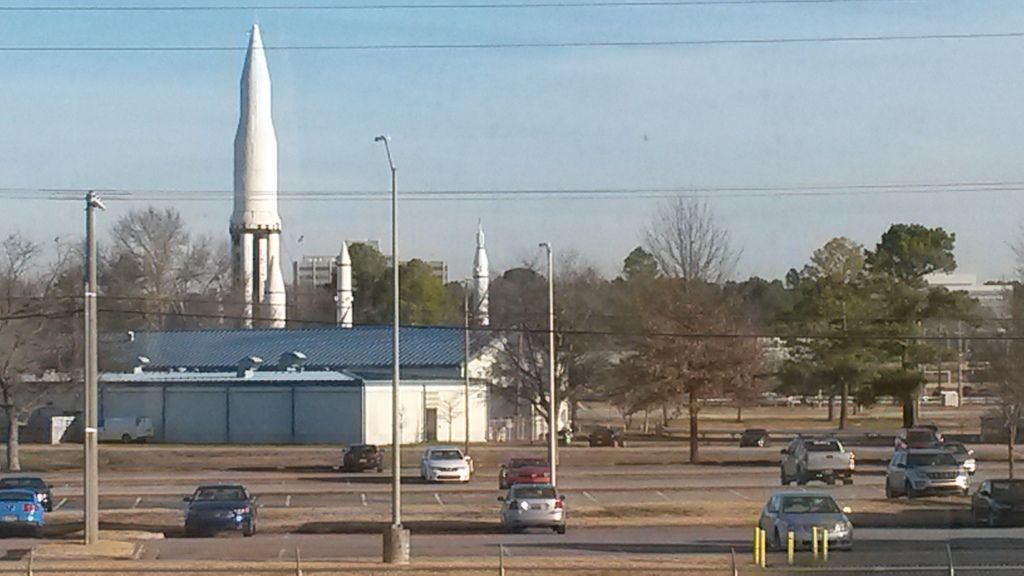
The "smallish" missile on the right is a Explorer-mounted Jupiter C. The next to the left is the Redstone (named for Redstone Arsenal where it was developed). The rather large one is the Saturn I-B, and the smaller one (hard to pick out) just in front of the Saturn I-B is a Jupiter (one of which carried the monkeys Able and Baker into space). Not visible due to the blue roof in the foreground are a Hermes, and a V-2 donated to the US Army in 1944 (the donator was under some duress at the time).
Yesterday, NASA allowed anyone working here at Marshall Space Flight Center the opportunity to see a piece of flight hardware which will be part of the first SLS launch next year. Below are pictures of the Orion Stage Adapter, which mounts between the second stage (Interim Cryogenic Propulsion Stage), and the Orion Command and Service Module. To maximize space utilization, the adapter incorporates fourteen canisters for launching
CubeSats (6U and 12U sizes) once the Orion module has separated from the ICPS. My current job is to develop electronics for the 6U CubeSat
NEA Scout. It will be pushed from its canister at a point between the Earth and Moon designated as "Bus Stop 2", somewhere outside the Van Allen belts. Enough talk, more pictures:
Orion Stage Adapter:
Outside view:
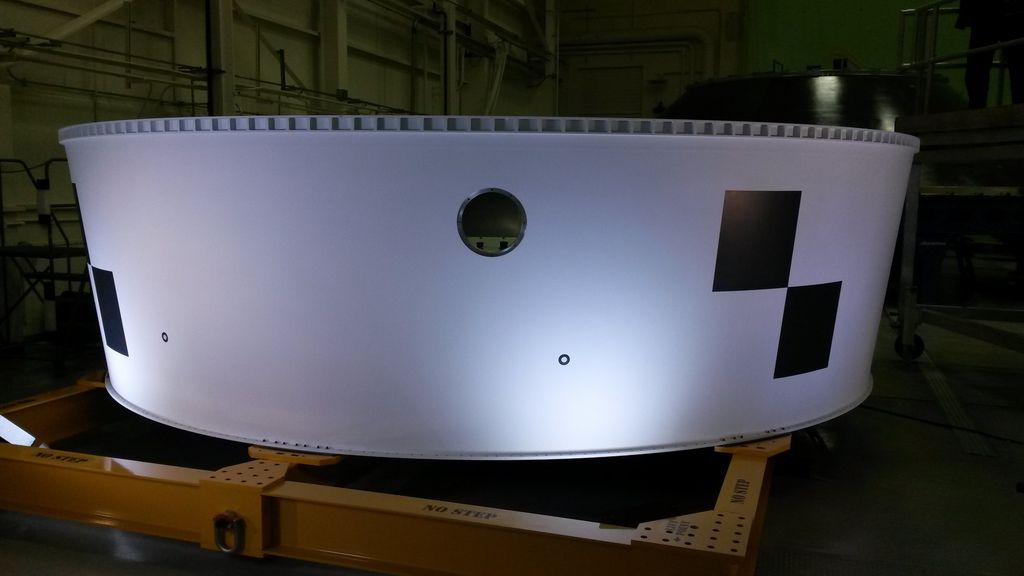
Inside view:

One of these scrawls is my signature so the aliens know who to blame:
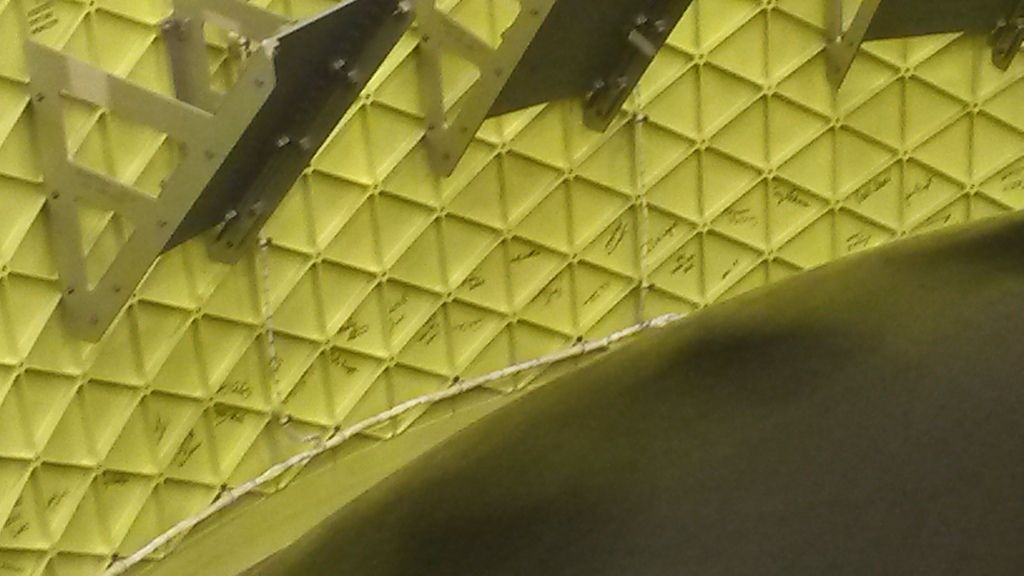
Pictures of the CubeSat to come later.
dave boling
Re: Side note to the APOD thread
Posted: Thu Feb 01, 2018 3:44 am
by trill
Way friggin' cool !
Re: Side note to the APOD thread
Posted: Thu Feb 01, 2018 8:07 am
by daveboling
Here's a couple of pictures of the 3D-printed model of the NEA Scout. Keep in mind that being a 6U CubeSat, the outside dimensions (including the space it takes to fold up the solar panels, is 10cm x 20cm x 30cm (3.9" x 7.9" x 11.8"), or about the size of a shoe box. The silver square is the sail. The blue bits at the corners are mounting points for the model, and not part of the spacecraft.
This is a scale model showing the relative sizes of the solar sail to the box it is dragging along. The model is ~12" x 12", so it could easily be passed about at a meeting.

Here's a view of the bottom side of the spacecraft, showing the solar panels deployed. The gold area represents a planar antenna used once the craft is outside the range of its omnidirectional antenna.
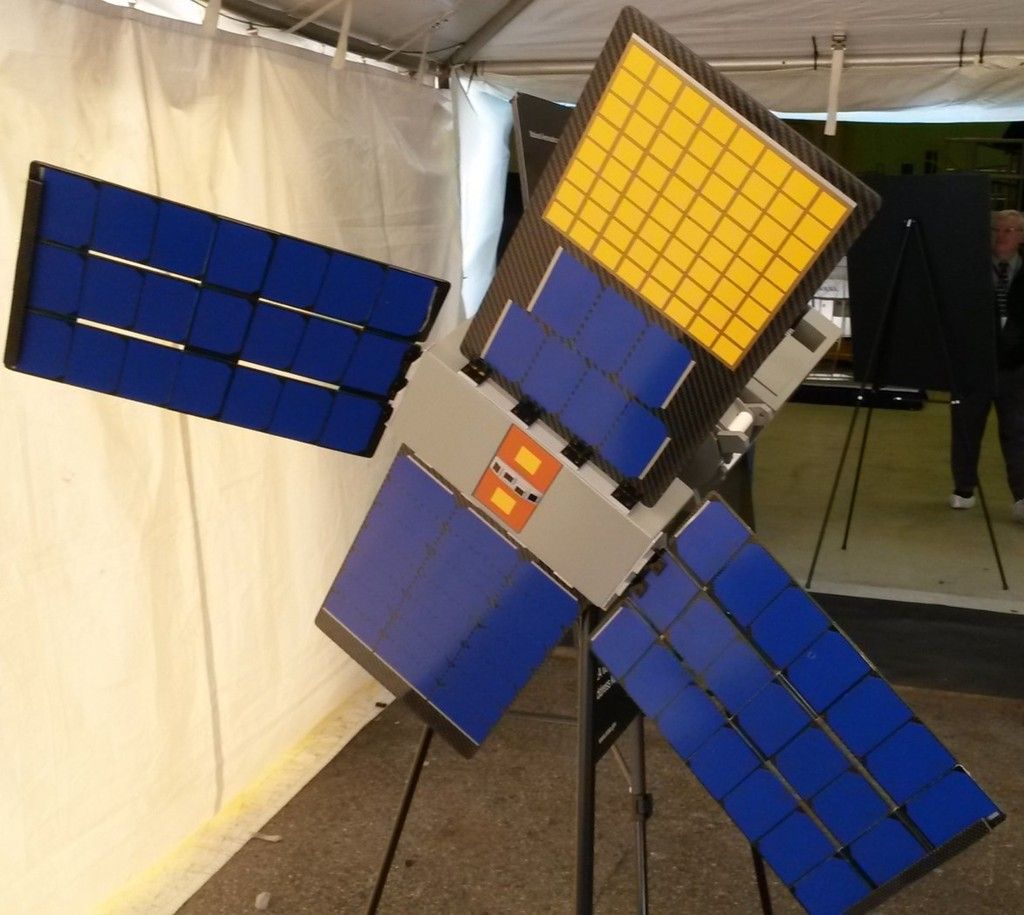
This is the view from the side. The open bit just to the left of the gold box attached to the solar panels is where the solar sail is spooled. With the sail being 84 square meters, and the booms being 6.8m long, the decision was made early on that they would be left out of this model

Also, the security guard in the background is not flight rated, and will not be flow on this launch.
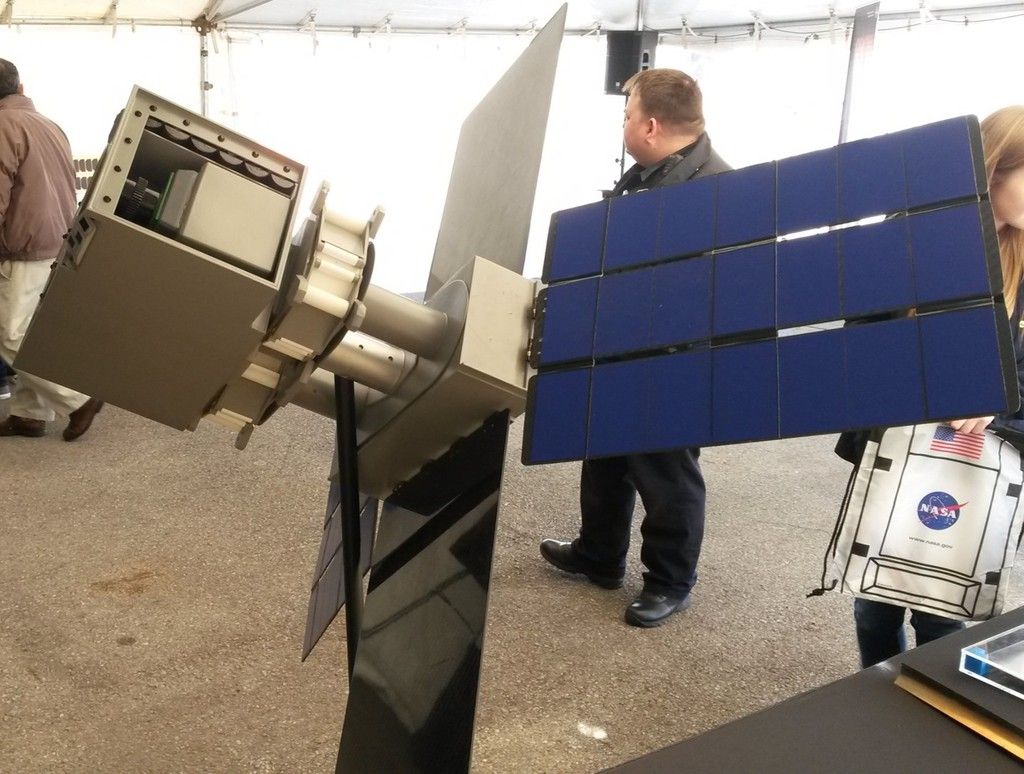
For the really geeky one's out here is a math problem: If a 84 square meter solar sail produces 9uN per square meter of thrust at 1 AU from the sun, and the load is 12kg, what is the delta v after 2.5 years?
dave boling
Re: Side note to the APOD thread
Posted: Sat Feb 24, 2018 8:48 pm
by Nanohedron
daveboling wrote:For the really geeky one's out here is a math problem: If a 84 square meter solar sail produces 9uN per square meter of thrust at 1 AU from the sun, and the load is 12kg, what is the delta v after 2.5 years?
Okay, I give up.
Re: Side note to the APOD thread
Posted: Sat Feb 24, 2018 8:58 pm
by Tunborough
Nanohedron wrote:daveboling wrote:For the really geeky one's out here is a math problem: If a 84 square meter solar sail produces 9uN per square meter of thrust at 1 AU from the sun, and the load is 12kg, what is the delta v after 2.5 years?
Okay, I give up.
I get 5 km per second.
Re: Side note to the APOD thread
Posted: Sat Feb 24, 2018 11:46 pm
by Chino
Fascinating, thanks for those inside pics Dave.

Re: Side note to the APOD thread
Posted: Sun Feb 25, 2018 3:43 am
by trill
I get:
delta-v of 3.1 km/sec
delta-range of 1 AU
(assuming pure radial motion, neglecting initial orbital motion and any stow-away security guards)
trill
Re: Side note to the APOD thread
Posted: Sun Feb 25, 2018 8:47 am
by Tunborough
trill wrote:I get:
delta-v of 3.1 km/sec
delta-range of 1 AU
(assuming pure radial motion, neglecting initial orbital motion and any stow-away security guards)
trill
I ignored that F was a function of range... Ok for a first-order approximation, but not good enough to get me to Mars, it seems
Re: Side note to the APOD thread
Posted: Mon Feb 26, 2018 10:54 am
by Innocent Bystander
Faskinating stuff! Thank you, DB!
Re: Side note to the APOD thread
Posted: Wed Aug 19, 2020 7:35 am
by daveboling
[Thread revival. - Mod]
An update on this thread.
NASA produces a YouTube video each week called, oddly enough, "This Week @ NASA". The "@" is to let you know they're up with the times enough that they don't use blueline machines anymore to create blueprints (Who's old enough to remember those, and the wonderful ammonia smell..?).
Anyway, in the August 14 edition (
https://www.youtube.com/watch?v=nHv5lQD ... e=youtu.be), beginning at 0:38, NEA Scout has a short feature where the mission is described, along with a CGI graphic of the spacecraft in flight, and a video of our flight sail deployment test. The deployment test didn't use the complete spacecraft, just the sail deployer, sail, and my motor driver board. If you look closely, you can easily pick me out:

dave boling
Re: Side note to the APOD thread
Posted: Fri Aug 21, 2020 1:15 pm
by Nanohedron
daveboling wrote: If you look closely, you can easily pick me out:

Caption:
"What happens if I do this?"
Re: Side note to the APOD thread
Posted: Thu Jun 10, 2021 8:01 am
by daveboling
Here's a link to a CGI timeline of the
NEA Scout mission on youtube. Sorry for the Muzak background, the team didn't get to pick the music. We would have gone for something more like "Magic Carpet Ride", "Radar Love", or something from the Ramones or B-52's...
The sail deployment actually takes about 15-20 minutes. The biggest challenge now is for the GNC guys (Guidance, Navigation, and Control). The actual flight path will depend on the launch time and date, what asteroids are within reach, and which direction we get pushed out of the dispenser.
dave boling
Re: Side note to the APOD thread
Posted: Sat Jun 12, 2021 5:41 pm
by Brus
daveboling wrote: ↑Wed Jan 31, 2018 8:21 am
The "smallish" missile on the right is a Explorer-mounted Jupiter C. The next to the left is the Redstone (named for Redstone Arsenal where it was developed). The rather large one is the Saturn I-B, and the smaller one (hard to pick out) just in front of the Saturn I-B is a Jupiter (one of which carried the monkeys Able and Baker into space). Not visible due to the blue roof in the foreground are a Hermes, and a V-2 donated to the US Army in 1944 (the donator was under some duress at the time).
When I was a kid, I was into model rocketry and made flying scale models of many of these: I got a Mercury-Redstone kit which on one flight dived nose-first into the ground, destroying the balsa-wood escape tower and most of the capsule, so I turned the rest into a Jupiter-C. I had Saturn 1B and V-2 kits as well. All from Estes Industries which is still in business the last I heard.
Re: Side note to the APOD thread
Posted: Mon Jun 21, 2021 9:26 am
by daveboling
Brus wrote: ↑Sat Jun 12, 2021 5:41 pm
daveboling wrote: ↑Wed Jan 31, 2018 8:21 am
The "smallish" missile on the right is a Explorer-mounted Jupiter C. The next to the left is the Redstone (named for Redstone Arsenal where it was developed). The rather large one is the Saturn I-B, and the smaller one (hard to pick out) just in front of the Saturn I-B is a Jupiter (one of which carried the monkeys Able and Baker into space). Not visible due to the blue roof in the foreground are a Hermes, and a V-2 donated to the US Army in 1944 (the donator was under some duress at the time).
When I was a kid, I was into model rocketry and made flying scale models of many of these: I got a Mercury-Redstone kit which on one flight dived nose-first into the ground, destroying the balsa-wood escape tower and most of the capsule, so I turned the rest into a Jupiter-C. I had Saturn 1B and V-2 kits as well. All from Estes Industries which is still in business the last I heard.
You need to visit the US Space and Rocket Center here in Huntsville. You can walk under and around a Saturn 1B, and see a restored (by the now-retired NASA people who built it) complete Apollo Saturn V rocket.
dave boling











